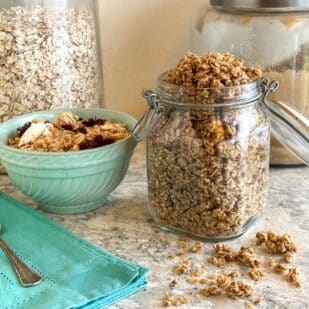
Low FODMAP High Protein Quinoa & Oat Granola
Looking for a high-protein breakfast? How about our Low FODMAP High Protein Quinoa & Oat Granola, complete with quinoa flakes, oats, chia seeds, and hemp seeds. Sweetened with a little bit of maple syrup and brown sugar and gently spiced with cinnamon, this is a low FODMAP granola like no other.
Low FODMAP Serving Size: Makes 7 cups (665 g); 14 servings; ½ cup (47 g) serving size
Ingredients:
- 3 cups (297 g) old-fashioned rolled oats; use gluten-free if following a gluten-free diet
- 1 cup (110 g) quinoa flakes, such as Ancient Harvest brand
- 1/3 cup (71 g) firmly packed light brown sugar
- ¼ cup (40 g) hulled or unhulled hemp seeds
- 2 tablespoons chia seeds
- 1 teaspoon cinnamon
- 1/4 teaspoon salt
- 2/3 cup (165 ml) neutral flavored vegetable oil, such as safflower, canola, or rice bran
- 1/3 cup (75 ml) maple syrup
Preparation:
-
Position rack in center of oven. Preheat oven to 325°F (165°C).
-
Place oats, quinoa flakes, brown sugar, hemp seeds, chia seeds, cinnamon, and salt in a large mixing bowl; stir to combine. Add oil and maple syrup and stir together until evenly mixed.
-
Spread out granola evenly on half-sheet pan. Bake for about 30 minutes total, stirring halfway through, until granola is light golden brown, crispy, dry, and fragrant.
-
Remove pan from oven and allow granola to cool completely on pan, then store at room temperature in an airtight container for up to 1 month. You can also freeze for up to 3 months. We love it for breakfast with low FODMAP lactose-free milk or dairy-free milk, tossed onto yogurt or even eaten out of hand for a snack.
Notes:
FODMAP Information
All recipes are based upon Monash University & FODMAP Friendly science at time of initial publication.
• Brown Sugar: Brown sugar has been lab tested by both Monash University and FODMAP Friendly. There are many kinds of brown sugar, from cane to beet (to blends) to Muscovado and more, which we discuss in our Explore An Ingredient: Sugar. Unfortunately, there is no information about what kind of brown sugars were lab tested. Monash gives us a low FODMAP amount of 1/4 cup or 40 g but no further information. In addition, in private correspondence with Monash University we know that there are amounts larger than 40 g that would be considered low FODMAP. FODMAP Friendly gives us a low FODMAP amount of 13 g. Dark brown Muscovado sugar does appear in a product lab tested and certified low FODMAP by FODMAP Friendly, so we do know there is a low FODMAP amount.
• Hemp Seeds: Both Monash University and FODMAP Friendly have lab tested hemp seeds. FODMAP Friendly gives them a “Pass” at 28 g. Monash gives them a low FODMAP serving size of 2 Australian tablespoons at 20 g.
• Maple Syrup: Both Monash University and FODMAP Friendly have lab tested maple syrup. Monash says that maple syrup is Green light and low FODMAP in servings of 2 Australian tablespoons (50 g). FODMAP Friendly gives it a “Pass” at 2 tablespoons (53 g). These amounts are recommended due to Australian healthy eating guidelines; no upper limit is posted by either Monash or FODMAP Friendly. Due to its chemical makeup, maple syrup contains more glucose than fructose and therefore can be considered free of FODMAPs. The FODMAP Friendly app does show you that no FODMAPs were detected in lab testing.
• Oats: Both Monash and FODMAP Friendly have lab tested oats. FODMAP Friendly gave rolled oats a “Pass” at ½ cup or 43 g servings; in an update to the app, they report Quick Oats as low FODMAP at 47 g, or ½ cup uncooked. Their max low FODMAP serving is 59.53 g. Monash has several app entries and some are country specific. Here we present their “basic” app entries which are not country specific (use your app to look up the other entries). For their main entry called “rolled oats” they say a Green Light low FODMAP serving is ½ cup, which they peg at 52 g. For “quick oats” they state that a low FODMAP serving is only ¼ cup at 23 g, becoming moderate Yellow Light at ½ cup or 47 g.
• Oil: All pure oils are fats and contain no carbohydrates, therefore they contain no FODMAPs.
• Spices: Many fresh and dried spice have been lab tested by both Monash University and FODMAP Friendly and are easily looked up in the apps, which we strongly suggest that you have. The additional good news is that if you are interested in a spice that has not been lab tested, you can look at the nutritional panel and assess its FODMAP load for yourself. If the “Sugars” and/or “Carbs” are 1 g or less per serving, then the item would be a good bet to try.
Please always refer to the Monash University & FODMAP Friendly smartphone apps for the most up-to-date lab tested information. Foods will be retested from time to time; in the case of raw ingredients, such as fruits and vegetables, results may vary. All lab tested results are valid and represent a snapshot in time. As always, your tolerance is what counts; please eat accordingly. The ultimate goal of the low FODMAP diet is to eat as broadly as possible, without triggering symptoms, for the healthiest microbiome.